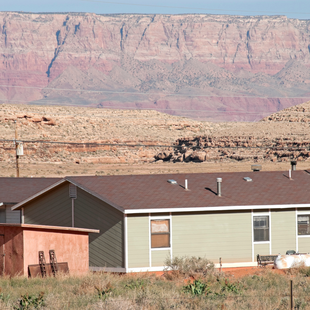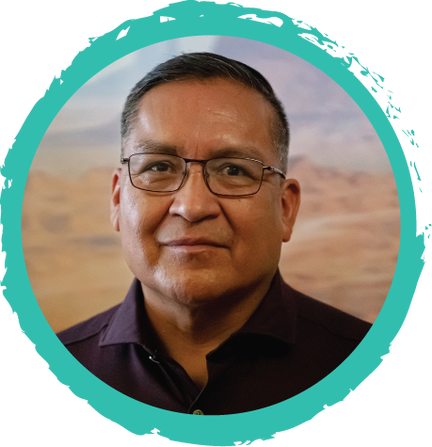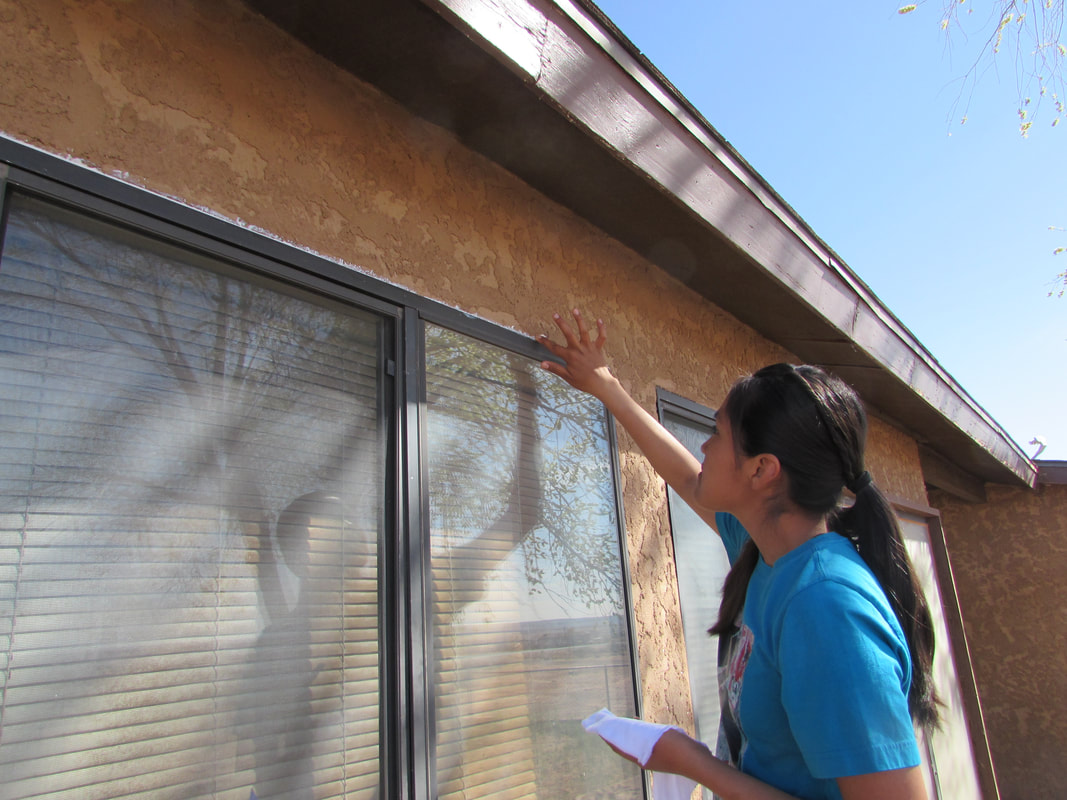|
Red Feather's Community Coordinator for Hopi, Alfred Lomahquahu, discusses his wide variety of experience serving the people, the ongoing housing needs on Hopi Tutskwa (Aboriginal Hopi lands) and how nonprofits can be uniquely situated to meet people where they are. Where We Fit and Why We Matter: The Role of Nonprofits in Community Housing Work  What makes Red Feather’s work so vital in the community? In my experience I haven’t really seen any other nonprofits working towards helping people maintain or improve their homes. Hopi has a lot of vibrant nonprofits and organizations working on a host of issues, but in the housing space Red Feather remains relatively unique. There is of course the government housing agencies; we have HUD housing here, but they are looking mainly at building new homes. A few years ago they were doing remodeling and renovations of older houses, and they did a pretty good job, but with HUD its always a long wait. It takes at least a year usually to get anything done or get help from HUD. And as with any agency, there is a lot of turnover, so that can make things hard. The problem is you have to basically be an expert in administration and NAHASDA legislation itself to get anything done- and that creates a challenge for anyone on the tribal side to really get the most out of that federal funding. The other problem we have with the HUD housing is that yes, they may have this money, but they have to spend it on scattered housing, on new subdevelopments, they can’t really do the community housing renovations and repair that Red Feather does. The whole process of actually getting assistance from HUD can also be challenging for individuals and homeowners. It can be very paperwork intensive and hard to gather all the information needed from the Village administration and other agencies, and this can just be prohibitive for some people. So Red Feather really provides the easiest pathway to help for people. And of course, we can still improve our own processes, we are always working on streamlining it, but it’s so much easier to do that as an independent nonprofit without all the government red tape. Even for our own Hopi Housing Authority, it can be hard for them to really get down to the bones of what we are doing at Red Feather, because they just don’t always have the staff capacity. The administrative burden can be immense. And they are the main entity out here that focuses on housing. Red Feather is really the only nonprofit that is in the housing space trying to fill the gaps in government housing assistance. When did you first get involved in this focus on community service? My first experience of community service was with the military. I was fortunate to be an engineer in the Marine Corps, so a lot of what we did was infrastructure projects in third-world countries. I spent a lot of time in Asia, Africa and the Middle East working on water, sewer and hygiene projects. So that community service mindset has been with me forever. Then working in tribal government, working as a Community Service Administrator, I’ve gotten to see how a variety of different agencies try to tackle these issues. How does your previous experience in tribal government inform your view of Red Feather and tribal housing issues? After working in tribal government, as the Vice Chairman and the CSA (Community Service Administrator), I wanted to really see how nonprofits work, and see how they fit in the picture of serving the people. As a CSA, your job is really to work for the people and provide services for the community. But their only budget is from the yearly tribal allotments, and that is not a lot. Due to Peabody closing their mine here, 80% of the Hopi tribal budget is gone. So the villages aren’t getting the tribal allotment that they used to get, because the tribe just doesn’t have that money anymore. Unfortunately, the village governments just don’t currently have the capacity to apply for and manage large grants. There just isn’t the administrative capacity to take that on at the local government level. So that’s where nonprofit organizations can come in and really shine. Red Feather doesn’t have term limits and changeovers and has experience managing grants. Our administrative system at Red Feather is set up for that, and so sometimes that allows us, as a nonprofit, to do things for the community right now that sometimes tribal government can’t. Navigating the bureaucratic system is challenging, and on the reservation, it can just take a long time to get things done. This can be good, we have our tribal decision-making processes for a reason, and because we have to navigate these outside systems that were never our systems, but the challenge can but getting things to move quickly. So outside entities like Red Feather that don’t have to follow the bureaucratic systems of HUD housing or tribal governments can really offer people help in a much quicker, more streamlined way. Any time you are dealing with any elected leadership, things are going to change. Nonprofits also can have this benefit of longevity. So yes, I see nonprofits as filling a huge gap in services, trying to address a huge unmet need. That’s why we exist. This can be overwhelming at times for staff, but if we have support, it can also be really rewarding. How do you see this nonprofit structure serving the Hopi community? Here at Hopi, no other group is doing home repairs, roof repairs, heating services……A lot of the people we are working with are on fixed incomes, so they can’t finance major home repairs. Which they would want to do themselves, but they can’t, it’s just not reasonable for them on a fixed income. Which goes for many people on the reservation. Most people who stay on the reservation are low-income, because of the lack of jobs. Unless you work for the tribe, or HIS (Indian Health Service) or the schools, but that’s probably only 20% of the population that has a reasonable job, most other people are on social security, using arts and crafts to try and survive, and those are the individuals we at Red Feather are really targeting. What are the biggest housing needs you see on a regular basis? Things like roof repairs are so vital, because if your roof is leaking or falling apart, everything inside your house will get ruined too. We get a lot of requests for roof repairs. These are also often really expensive, so harder for people to self-finance. A lot of people are also living in G-sheds, these tiny home shells, because that is what they can afford. Those are the homes that really need help, because a G-shed doesn’t come with wiring, insulation, plumbing, or any type of heating, it’s just a shell. So people are living in these shells. And because they aren’t considered ‘proper housing’ IHS can’t connect them to plumbing and water services. So people can’t really get the services they need. Some villages will hook these types of homes up to electricity, some won’t. But if these people can’t get any water services, Red Feather can at least help them get water storage tanks, install septic tanks, etc. So Red Feather really is filling in a huge gap, because these are just basic sanitation and hygiene needs. Even me, now that I’m back at Hopi, and working full time, it can still be challenging to get basic amenities. I live in a house without power and plumbing too. This is often just part of our life. So yes, I see nonprofits as filling a huge gap in services, trying to address a huge unmet need. That’s why we exist. This can be overwhelming at times for staff, but if we have support, it can also be really rewarding.
Even with HUD, there are lots of programs to help individuals get home loans, but not on the reservation. There is a gray area about what HUD can and can’t really do on reservation land.
So most people are living in what they can afford out-of-pocket. So we’re back to G-sheds, because people can get a downpayment for a G-shed together, but even then they will end up paying so much more than the value of those sheds over the lifetime of their payments. But if that’s the option you have, that’s the option you have. The other thing we see a lot of is people needing help repairing after house fires. No one has insurance on the reservation. So if you have a house fire, I mean, you can lose everything. So who comes if you need to fix a home after a fire? Red Feather. I’m currently working with three families dealing with the aftermath of home fires. Two of the homes are still livable, and they just need their roofs repaired so the family can move back in. So we’re working on helping to make that happen. At least that is something we can do that not a lot of other groups or people can do. And our footprint is just expanding. More and more people are hearing about Red Feather and our work, which is great but we definitely will get completely overwhelmed at some point. We don’t want to limit people or cut off services, because that defeats the purpose of why we are here. We want to help as much as we can, so then it’s just a question of how we are going to grow and increase our own capacity. What has been the most impactful thing for you so far in doing this work? To see the people happy, especially the elderly. They are always so grateful. They are always like “we’ve never gotten anything, we never get any help, no one’s even come by to check on us or follow up or anything”. So even when we just deliver firewood or those sorts of smaller solutions, it can make such a difference. It’s just really impactful to see people getting the services they really need. What would you like to see in the future? I would like to see us deepen our involvement with the Village CSAs. They really are the point-people for providing community-based support to each village, and it can be hard to build lasting connections because there is a lot of change-over for CSA’s, but Red Feather can really support them to help them help their people. So I would like to see us continue to deepen those relationships at the CSA level, to make sure we are working together as much as possible. |
Archives
June 2023
Categories
All
|
|
Change your mind at any time by clicking 'unsubscribe' in any email you receive or by contacting us at [email protected]. We will treat your information with respect. For more information about our privacy practices please see our privacy policy. By clicking above, you agree that we may process your information in accordance with these terms.
In compliance with all GDPR requirements- you can request any data you’ve shared with Red Feather to be permanently deleted from our records by contacting us at [email protected]. |
WORKING WITH HOPI AND DINÉ
COMMUNITIES FOR HEALTHIER AND SAFER HOMES.
LAND ACKNOWLEDGEMENT: The Red Feather program office sits in an area that is sacred to over 14 local tribes, including the Diné, Hopi, Havasupai, Hualapai, Zuni, Pueblo, and Kaibab-Paiute peoples. Some of these nations are represented among the Red Feather staff, and some not. We humbly acknowledge this area’s Indigenous nations, original stewards and Native descendants who will forever know this place as home. We share a responsibility to recognize and acknowledge the people, cultures, and histories that make up our community. *Adapted from the Flagstaff City Council land acknowledgement developed by the Indigenous Commission

If you have a disability that limits your ability to access our facilities, please contact us so we can arrange for an alternative meeting location. See our ADA access plan here.
This institution is an equal opportunity provider. |




 RSS Feed
RSS Feed

